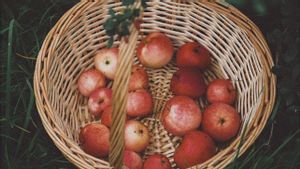JAKARTA - Who doesn't know mint leaves? Leaves that are often used as decorations for food or drinks can be used as detoxification ingredients. Especially when breaking the fast. mint plants, especially parts of the leaves have radioprotective, antioxidant, anti-carcinogenic, anti-alergic, anti-passosmodic (cough anti-cough) ingredients, carminative drugs (minors), antiseptic, antipruritic and diaphoretic (warming and inducing sweat).
In addition, the aroma of the peppermint can be used as an inhalan for shortness of breath, even the peppermint tea is also used for cough, bronchitis, and inflammation of the oral and throat cavities.
In general, the use of mint leaves in the form of fresh leaves can be done in a way. Add enough leaves in a mixture of tea, infuse water, or mixtures with several other ingredients such as ginger and lemon.
Seeing the benefits that are good for the body, you can plant it yourself to make it easier and more practical if one day it is needed.
Because mint plants grow aggressively. It is better to separate these plants from your other plants, otherwise the mints will take all the nutrients from the surrounding plants. It is recommended, grow mints in containers so that these plants do not spread widely to other areas in the park.
If you grow a mint in the gaps of the footpath and between rocky places in the places you often pass. Mint will emit its aromatic aroma every time the leaves are stepped on and crushed.
Mint can be planted in indoor and outdoor containers or planted directly on the ground. When planting mints on the ground, choose a spacious place so that mint growth does not cause problems.
mint plants are best planted in humid places with good drainage. But also in places that are exposed to full sunlight or partially shady. This plant likes fertile soil enriched with compost. Plant its roots on the ground, cover it with at least 1 to 2 inches of soil above it.
Plant mint pieces or small plants purchased 18 inches to 2 feet outside the room. Two plants should cover enough meters of soil, as mint plants grow aggressively. This plant has a shallow root system, so you don't have to dig too deep. The important thing is to put about one to two inches of soil above it. To prevent the spread of mints, add the outskirts around the planting area 18 to 24 inches deep into the ground or plant them in containers.
Light
mint plants prefer a shady spot, though this plant will continue to grow in full sunlight if you water it frequently. However, the best thing is to protect it from the hot afternoon sun. Mint can also survive in a fairly shady condition, although it may be long-legged and does not produce a lot of leaves or smell.
Land
Mint can adapt to most soil types, but prefers fertile soil with slightly acidic pH to neutral. Good soil drainage is also important. mint plants like water, but inundated soil can make the roots rot.
Water
Water mint leaves during the dry season in order to keep the soil moist, add more water when the top of the soil feels dry when touched. Maintaining a rather humid but not wet soil is the ideal environment for mint plants. If you see the leaves wither, it is usually a sign that plants need more moisture. The best watering time is in the morning so that plants have a lot of moisture during the day when the temperature increases.
Fertilizer
Give fertilizer (every 4 to 6 weeks) during the planting season if your soil is malnutrient. If you already have fertile garden soil, you most likely don't need to give additional fertilizer to mint plants.
Snacks
mint plants do cross pollination, meaning that different varieties will pollinate each other if they are planted close together. This produces new seeds that will grow as a result of the crossover of the two plants. In order for plants not to produce hybrid seeds, plant them separately from each other in containers or with different gardens.
SEE ALSO:
Mint is usually not exposed to pests or disease. However, stressed plants can be disturbed by common park pests, including white flies, spider mites, leafbugs, and whitebugs. mint plants can sometimes be carat, which appear as small orange spots at the bottom of the leaves. Use fungicides, and let plants dry up among the watering.
The English, Chinese, Japanese, Arabic, and French versions are automatically generated by the AI. So there may still be inaccuracies in translating, please always see Indonesian as our main language. (system supported by DigitalSiber.id)


















